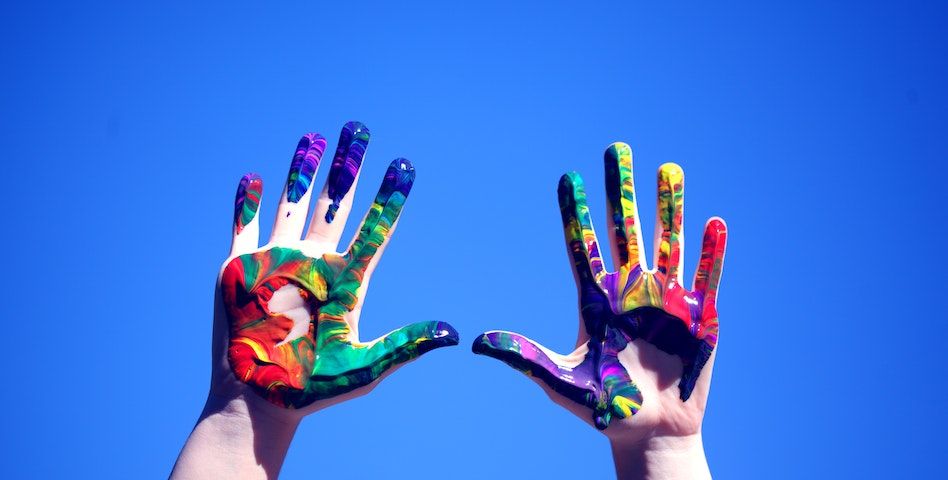Understanding Color Palette: Primary, Secondary, and Tertiary Colors for Creative Benefits
Color is an integral part of our lives, influencing our emotions, perceptions, and even decision-making processes. In the world of design, whether it's graphic design, interior design, or any other creative field, understanding the use of color is paramount. In this blog, we'll delve into the concept of color palettes, exploring primary, secondary, and tertiary colors and how their thoughtful application can have significant creative and psychological benefits.
The Basics of Color Theory
Before we dive into the world of primary, secondary, and tertiary colors, it's essential to understand the fundamentals of color theory. Color theory encompasses a range of principles that explain how colors interact and how they can be combined effectively to create visually appealing compositions.

Primary Colors: The Building Blocks
Primary colors are the foundation of the color wheel. There are three primary colors:
1. Red: Often associated with passion, love, and energy, red is a bold and attention-grabbing color. It can evoke strong emotions and is commonly used to convey excitement or urgency.
2. Blue: Blue is frequently linked to calmness, trustworthiness, and reliability. It is a versatile color that can convey both professionalism and a sense of tranquility.
3. Yellow: Yellow is the color of happiness, optimism, and creativity. It can add a vibrant and cheerful touch to any design.
Secondary Colors: Mixing the Basics
Secondary colors are created by mixing equal parts of two primary colors. There are three secondary colors:
1. Green (Blue + Yellow): Green represents growth, freshness, and harmony. It's often used to convey nature-related themes or a sense of balance.
2. Purple (Blue + Red): Purple is associated with luxury, creativity, and spirituality. It can add a touch of sophistication and elegance to designs.
3. Orange (Red + Yellow): Orange is a color of energy, enthusiasm, and warmth. It can create a sense of vibrancy and playfulness.
Tertiary Colors: Complex Blends
Tertiary colors are created by mixing a primary color with an adjacent secondary color. These colors offer a wide range of possibilities for creative expression. Some common tertiary colors include:
1. Red-Orange: This color is a fiery blend of red's passion and orange's vibrancy. It can convey a sense of excitement and adventure.
2. Blue-Green: Blue-green combines the calming qualities of blue with the freshness of green. It's often used to evoke feelings of tranquility and balance.
3. Yellow-Green: Yellow-green is a bright and energetic color that symbolizes growth and vitality. It's associated with nature and rejuvenation.
4. Red-Purple: This color combines the richness of red with the sophistication of purple. It can convey a sense of luxury and creativity.
5. Blue-Purple: Blue-purple strikes a balance between the calming qualities of blue and the elegance of purple. It can add a touch of mystery and depth to designs.
The Benefits of a Thoughtful Color Palette
Now that we've explored the primary, secondary, and tertiary colors, let's discuss how a well-planned color palette can bring numerous benefits to creative endeavors:
1. Visual Harmony: A thoughtfully chosen color palette creates visual harmony in designs, making them more aesthetically pleasing and easier to digest.

2. Emotional Impact: Colors have the power to evoke emotions and influence moods. By understanding color psychology, designers can elicit specific emotional responses from their audience.
3. Brand Identity: In branding and marketing, a consistent color palette can help establish and reinforce brand identity. Customers often associate certain colors with specific qualities or values.
4. Readability and Accessibility: The use of appropriate color combinations enhances readability and ensures that content is accessible to all, including those with visual impairments.
5. Effective Communication: Colors can be used to highlight important information, create visual hierarchy, and guide the viewer's attention to key elements.
6. Cultural Significance: Colors may hold different cultural meanings and significance. Being aware of these cultural associations is crucial, especially for global designs and marketing campaigns.
7. Versatility: A well-balanced color palette offers versatility, allowing designers to adapt their work to various contexts and applications.
Creating Your Color Palette
When creating a color palette for your project, consider the following tips:
1. Start with a Base Color: Begin by selecting a primary color that represents the overall mood or theme of your project.
2. Choose Complementary Colors: Select secondary and tertiary colors that complement your base color and convey the desired emotions or messages.
3. Test for Accessibility: Ensure that your chosen color combinations meet accessibility standards, making your content inclusive to all audiences.
4. Keep It Simple: Avoid overwhelming your audience with too many colors. A palette with three to five well-chosen colors is often sufficient.
5. Test in Different Contexts: Assess how your color palette appears in various lighting conditions and on different devices to ensure consistency.

Conclusion
Understanding the use of primary, secondary, and tertiary colors and their thoughtful application in your creative projects can significantly enhance your work. Color palettes are not just about aesthetics; they have the power to convey emotions, establish brand identities, and communicate messages effectively. By mastering the art of color, designers can create visually captivating and emotionally resonant experiences for their audiences.